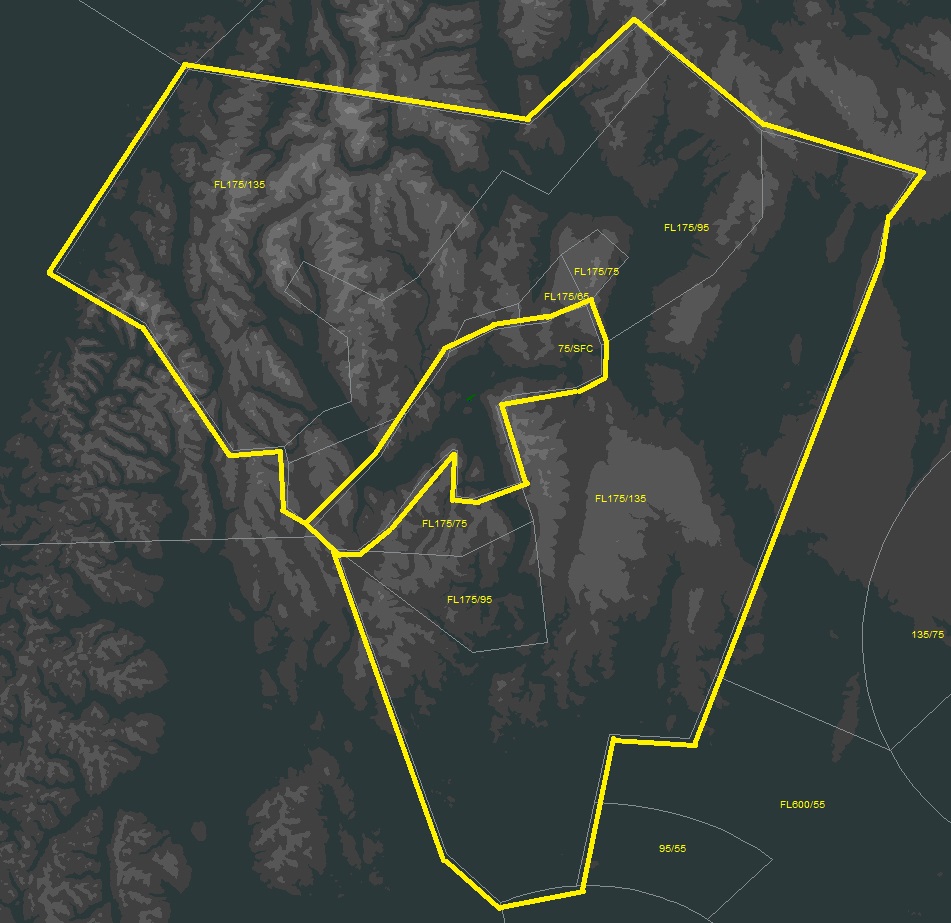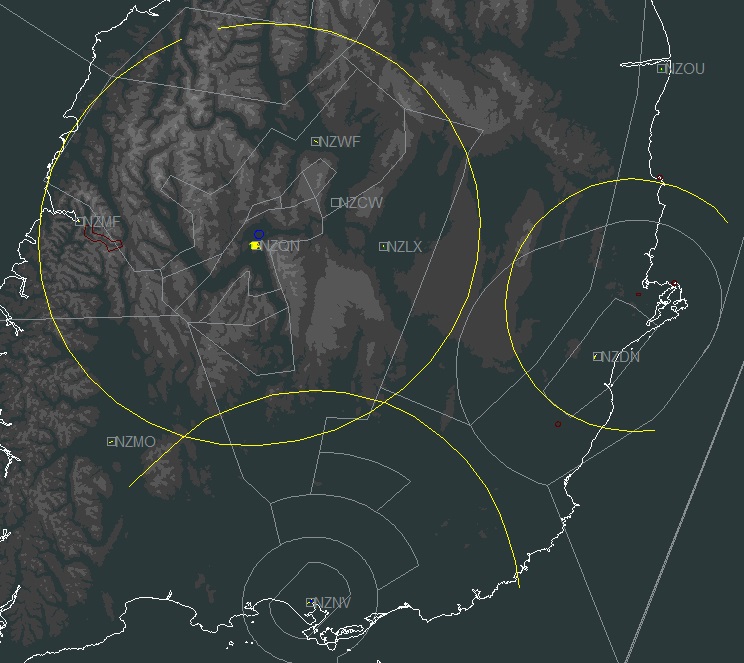Queenstown TMA
Section 1: Terminal Control
1.1 Area of Responsibility:
NZQN_APP (Queenstown Approach) is responsible for all controlled airspace within their designated area of responsibility, excluding Queenstown Tower CTR/C Airspace when Tower is online.
Airspace boundary shown below in yellow. Controls up to FL175.

Coordination boundaries are shown below in yellow.
The coordination point between any traffic flying between Invercargill Tower and Queenstown Approach airspace is 50 DME NV VOR.

1.2 Frequency and Sector Information:
| Callsign | NZQN_APP |
| Primary Frequency | 125.750 MHz |
| RTF Designator | Queenstown Approach |
| Sector Name | Queenstown Terminal |
| Sector Abbreviation | QAT/QTMA |
| Telephone Designator | Queenstown Terminal |
1.3 IFR - Star Arrivals
Aircraft on all arrivals shall be descended to 10,000 feet.
Examples
- Cleared ELRUV#A arrival runway 05, descend via the star profile to one zero thousand, Queenstown QNH XXXX
- Cleared UBDAN#B arrival runway 23, descend via the star profile to one zero thousand, Queenstown QNH XXXX
- Descend via the star profile to one zero thousand, Queenstown QNH XXXX
If the required separation is met, the Queenstown Approach controllers may elect to clear the aircraft for the approach at the same time. For example,
- Descend via the star profile to one zero thousand, cleared RNAV Y RWY23, QNH XXXX.
1.3.1 Star Arrivals Runway 05
- ELRUV2A
- SUNGU3A
- UBDAN3A (Transitions ADKOS, LIBLA DOVOT)
1.3.2 Star Arrivals Runway 23
- ELRUV4B
- SUNGU4B
- UBDAN4B (Transitions ADKOS, LIBLA DOVOT)
1.4 IFR Approaches
The nominated approach into Queenstown for aircraft Category C or above shall be the RNAV (RNP) Yankee. This covers anything from a medium turboprop to a jet aircraft. The RNAV (RNP) Zulu is available for aircraft Category B or below only.
There are no differences in RNAV path between these two approaches. The only differences are descent minima and required go-around performance.
Runway 05 approaches begin at IBABU.
Runway 23 approaches begin at UGPED or ATKIL, before merging onto the same RNAV path.
Make sure you clear the aircraft for the approach before it reaches the above fixes.
Examples
- Cleared RNAV FOXTROT approach [circling for] runway 05
- Cleared RNAV YANKEE approach runway 23
- Cleared VOR/DME BRAVO approach [circling for] runway 23
Important
When issuing aircraft holding instructions, controllers should make every effort to issue an expected approach time or expected number of laps of the hold - based on hold timing of 4-5 minutes per hold.
Note 1 - [circling for] is not compulsory, covered in detail in Queenstown Tower Procedures.
Note 2 - The RNAV YANKEE, GOLF & FOXTROT can all be displayed in Euroscope to check the plane is on course.
1.4.1 Approaches Runway 05
- RNAV FOXTROT (CIRCLING)
- RNAV YANKEE (RNP)
- VOR/DME CHARLIE (CIRCLING)
1.4.2 Approaches Runway 23
- RNAV GOLF (CIRCLING)
- RNAV YANKEE (RNP)
- VOR/DME BRAVO (CIRCLING)
1.5 IFR - Departures
You should be aware some SID's have hold downs (altitude restrictions). eg ANPOV3B/23 (Cross RUXAK at or below 9,000ft)
Once an aircraft reaches 10,000 ft, traffic permitting, the SID may be cancelled and a track direct to waypoints and/or a radar vector within the Queenstown Terminal may be issued. Direct to waypoints outside of the Queenstown Terminal require co-ordination with NZCH-S_CTR.
Queenstown Approach may identify aircraft and provide radar vectors to aircraft provided they are above the MSA. Furthermore, Queenstown Approach controllers should also make good use of the term "radar terrain".
1.6 Holds
There are three holding points around Queenstown.
- EKVOX (Left turns, min alt 8600)
- SUNGU (Left turns, min alt 8600)
- UBDAM (Left turns, min alt 11,400)
1.7 Standard Descents
Descents for arriving aircraft into the Queenstown TMA shall be to FL150.
When holding is taking place, descents must be no lower than FL150 unless otherwise co-ordinated with NZQN_APP.
1.8 - Transfer of Communications
Arriving Aircraft - Once nearing 8,000 feet or nearing the Queenstown Tower control boundary.
Departing Aircraft - Once nearing FL175 or nearing Queenstown TMA control boundary.

